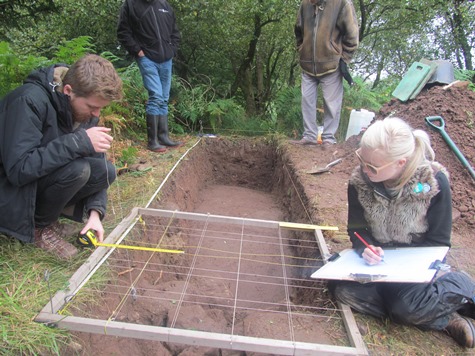5,000 year old Prehistoric art panel uncovered
Published: 8 September 2016
The “most important Neolithic cup and ring marked rock art panel in Europe” is being unearthed for the first time in 50 years - near a housing estate in Clydebank near Glasgow.
The “most important Neolithic cup and ring marked rock art panel in Europe” is being unearthed for the first time in 50 years on the edge of a housing estate in Clydebank near Glasgow.
The Cochno Stone, dating back to 3000BC, and one of the best examples of Neolithic or Bronze Age cup and ring markings in Europe, is being fully excavated for the first time since it was buried in 1965 to protect it from vandalism.
Dr Kenny Brophy discusses his work on the Cochno Stone
The stone, which lies on land next to a housing estate near Faifley, in West Dunbartonshire, is regarded as one of the UK’s most important, but also one of its most neglected, prehistoric sites.
The excavation will provide the opportunity to use cutting-edge 3D imaging technology to make a detailed digital record of the site, which should shine more light on the stone’s history, its purpose and the people who created the artwork around 5,000 years ago.
Dr Kenny Brophy, from the University of Glasgow who specialises in urban archaeology, is leading the excavation at the site next to Cochno Farm.
He said: “This is the biggest and I would argue one of the most important Neolithic art panels in Europe. The cup and ring marks are extensive but the site just happens to be in the middle of an urban housing scheme in Clydebank.
“It was last fully open to the elements and the public up until 1965. Sadly as it was neglected it was also being damaged through vandalism and people traipsing all over it. So renowned archaeologist Ludovic Maclellan Mann, with a team of experts, decided the best way to preserve it was to cover it over to protect it from further damage. And it has lain there ever since.
“It has been well recorded for archaeological purposes but we now feel the time, and the technology, is right to unearth it and see what new elements we can learn about its history and the people who created it. The local community is very engaged in what we plan to do, and they seem very proud to have this amazing prehistoric gem right on their door step.”

‘Revealing the Cochno Stone’ project is a collaboration between the Factum Foundation for Digital Technology in Conservation and the University of Glasgow Archaeology Department.
The aim of the project is to gather 3D data at the highest possible resolution of the surface of the Neolithic artwork, then rebury the Cochno Stone, which measures 8m x 13 m. Ultimately, Factum Foundation hopes to produce a 1:1 facsimile of the panel, using a combination of the recorded digital data and historical sources.
Ferdinand Saumarez Smith, leading the Factum Foundation Digital Imaging team, said: “Factum Foundation captured the world’s attention through its 3D scanning work that led to the discovery of evidence of a new chamber in the tomb of Tutankhamun. With the Cochno Stone, we are going to use similar recording methods to bring the world’s attention to Scotland’s equally important, mysterious and beautiful heritage.
The Cochno Stone was taken away from the people of Clydebank in 1965 because of vandalism. We are going to show how digital technology can be used to resurrect this lost monument and give it back to the people it belongs to, because we believe that if we trust people, they will look after it.
We want to send a message to Scotland, saying this is your culture to take pride in - and if you want it preserved, understood and appreciated you need to show us your support!”
The Cochno Stone tells a story that reflects the issues around the preservation of cultural heritage in the face of encroaching urbanisation. A trial excavation undertaken in September 2015 revealed that the stone is still in good condition, but that modern graffiti is probably extensive across the stone’s surface.
The facsimile would reflect these various layers of history by including the pre-1965 graffiti as well as the prehistoric surface, accurately recorded using a variety of digital imaging techniques including aerial photography and Faro Laser Scanning.
Further information contact Jane Chilton, Univeristy of Glasgow communications 0141 330 3535 / jane.chilton@glasgow.ac.uk
First published: 8 September 2016
<< September
Related links:

